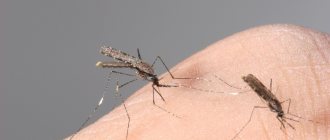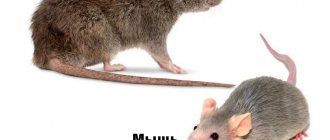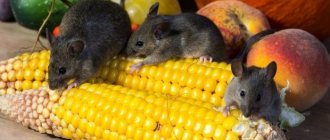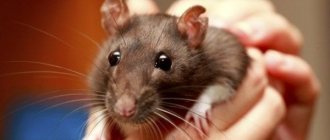Main causes of pet bites
Wild and domesticated rats have completely different motivations for biting. For rodents of the first group, any person is a dangerous adversary. Their behavior is subordinated to precisely this attitude, which encourages them to use their sharp teeth.
Domesticated rats are initially peaceful. They are smart, easy to train, and love their owner. The wild instincts of these rodents rarely manifest themselves only in relation to relatives, and then only in conflict situations. Therefore, if a domestic rat has bitten a person, it is imperative to find out the cause of such an extraordinary event in order to prevent its recurrence in the future.
Most often, rat bites occur after:
- causing pain to an animal;
- fright;
- fasting;
- stressful situation.
Quite often, animal breeders note that a rat has bitten a person after the animal was ignored for a long time by the owner. You can’t explain to your pet that you don’t have enough time for daily activities with him. For a rat, lack of attention and communication with a person means almost punishment and causes a negative reaction.
It is necessary to distinguish when an animal bites seriously, drawing blood, and when it simply bites to express dissatisfaction. Such warning bites are typical for domestic rodents. In this way, the animals make it clear that human actions are approaching a dangerous line. For example, this happens when the animal is squeezed too tightly in the palms or is not released from the hands for a long time.
Many pet owners make mistakes when dealing with rodents and overlook the fact that they are setting a bad example for their children. Most cases where a rat has bitten a child are based precisely on copying errors or on insufficient awareness of children. Before buying a rodent, you need to tell your child about the rules for handling the animal.
Sometimes a domestic rat bites because of the strong smell of food from human hands - it confuses the palm with a treat. One of the basic rules for rodent breeders is to thoroughly wash your hands before handling your pets.
It is not uncommon for other pets to be bitten. The causes of rodent aggression in such situations are:
- protecting your site;
- fear;
- the provoking smell of a stranger.
The injured pet must be treated immediately with hydrogen peroxide or chlorhexidine (do not rub, just blot). Such bites usually take a long time to heal. If after 10–12 hours the “wounded” person’s appetite worsens, lethargy and irritability appear, the rodent and the victim must be shown to a doctor.
Rat attack
Large rodents are capable of attacking and rushing at a person completely unexpectedly, often this happens in 2 ways:
- In order to scare, a rat rushes at a person and makes a jump, emitting a squeal or squeak. The reason for such an attack is fear, when the animal is driven into a corner, and it acts in self-defense.
- Cases of attacks on sleeping people often happen to drunken or homeless people who spend the night in basements, sewers, dirty corners of gateways, which rats consider their territory. However, rumors that rats ate someone whole are greatly exaggerated.
Reasons for aggressiveness of rat pups
There are frequent cases of aggression on the part of young animals, teenage rats. Such animals sometimes behave like wild ones, are frightened by the approach of people, and often huddle in a house inside a cage. It is dangerous to handle such animals.
The causes of aggressiveness in young animals are often:
- lack of attention and education on the part of the breeder;
- hereditary predisposition;
- rough treatment of animals;
- mistakes that were made by the owner.
If you do not pay enough attention to a decorative rat, the animal grows unpredictable. But these animals need very little: to be held correctly, not to cause pain, to play from time to time, to be treated to something tasty. It is also worth remembering that even the most well-mannered rat can bite its owner if he pushes food between the bars of the cage with his fingers. The animal will easily confuse your fingers with a treat.
Important! It has been established that rodents infected with a viral infection lose fear and their desire to hide from strangers disappears. Such animals are aggressive and very dangerous.
Why did the rat suddenly start biting?
When asked whether domestic rats bite, zoologists and veterinarians answer positively. It all depends on the circumstances and the physical condition of the animal. It happens that visually imperceptible fluctuations in hormonal levels in the body of a domestic rat cause mood swings in the animal and lead to aggression. In males (in most cases) this is associated with puberty, in females - with the onset of pregnancy.
Each rodent grows differently. There are pets whose emotional amplitude is very small. They are distinguished by their even and calm behavior even during puberty. There are other animals: in some males, closer to 7 months, the character changes dramatically. The previously playful and sociable animal begins to strive for solitude, defend its right to the inviolability of personal territory, and bite.
In females, hormonal surges are observed during pregnancy and caring for the young. Rats are tender mothers; they guard their newborn babies day and night. In such a situation, even a slight danger or anxiety can serve as a motivating motive for the rat to bite.
Interesting! If a rat released for a walk is aggressive (the fur on the back of the neck is raised, the ears are flattened), it may well bite. In such a situation, there is no need to make sharp gestures.
In what cases is an animal attack possible?
A rat attacks a person only as a last resort, when it has no other options to save or protect its offspring. During an attack, the rodent is able to rush at its enemy and bite him, causing severe pain.
Interesting! More than 3,500,000 cases of rat attacks on people are recorded annually around the world.
Self-defense
Most often, a rat attacks a person or an animal hunting it (for example, a cat), out of a desire to save its own life. However, she does this only if there is no way to escape or hide in a safe place. During self-defense, the rodent tries to bite the enemy. In addition, he intimidates the uninvited guest by jumping and loud rat squeaking.
If you accidentally encounter a brave mammal, it is better not to take risks and give it the opportunity to escape.
Interesting! The average bite force of a rat is 500 kg/cm2.
Hunger
Rats are omnivores. They can pick up food scraps found in landfills, destroy granaries, run into chicken coops and other accessible buildings. Among these rodents there are cannibals. If they are very hungry, they can feed on dead rats or hunt cubs.
People become victims of a hungry rat extremely rarely. In most cases, this happens in poor countries where rodents cannot find other food. During an attack, the mammal bites off a piece of skin or flesh and then quickly runs away to a secluded place.
Objects of rat attack:
- Small children;
- connected people;
- immobilized patients;
- people who are heavily intoxicated.
Human provocations
There are people who like to tease animals, including rats. Such a rash action can frighten the rodent and force it to attack the offender.
Possible consequences of provocation:
- painful bite;
- scratching;
- damage to various parts of the body (for example, eyes).
Rabies
Rats love to walk around and look for food in places where people live. Under favorable conditions for rodents, the number of individuals in the colony will gradually increase. At the same time, the risk of rabies spreading will increase.
A sick animal behaves aggressively, as its sense of fear is dulled. Because of this, the rat can attack even large animals and humans. One bite will be enough to become infected with this dangerous disease.
Increased aggressiveness of females
Rats fiercely protect their offspring. Noticing potential danger, the female begins to rush at the enemy. At the same time, she tries to intimidate him and take him away from the kids.
If a predatory animal or person tries to destroy the nest, the rat will bravely defend it, not sparing its own life.
First aid for a bite
If bitten by a rat, the person needs urgent help. As a rule, the wound is deep and painful. Its peculiarity is the high rate of cell regeneration at the edges and low in the center. This causes a characteristic clinical picture: the blood along the perimeter of the deformation of the epidermis quickly stops. This situation increases the chances of human infection if the animal has been infected.
Any owner of a pet rat should know what to do in this case, how to help himself at home:
- Apply light pressure to the wound to release blood.
- Rinse the rat bite. Hold the wound under running water for 5–6 minutes.
- Apply any antiseptic (hydrogen peroxide, chlorhexidine) to the bite area.
- Treat the affected area with iodine or brilliant green.
- Place a small swab on the wound and secure with adhesive tape.
After the treatment, you should pay attention to changes in well-being and monitor your health over the next 4–5 days. It is better not to wet the bite site; wash dishes with gloves.
Important! The rate of healing of a wound after a rat bite depends on the health of the animal (at the time of the attack), whether it has mandatory vaccinations, and the quality of keeping the pet in the cage. If the rat's home is not cleaned regularly, there is a high risk of infection in the wound.
Can a person get sick after being bitten by a pet rat?
Rodents have long been considered carriers of diseases, the most dangerous of which are leptospirosis, tetanus and sodoku. If an animal is sick with leptospirosis, for a person this is fraught with the development of paralysis, myocarditis, renal failure, and infectious-toxic shock. The bite in this case is completely optional; it is enough to finish the bread that was bitten by the sick animal.
According to research, 10% of people who become infected with sodoku after being bitten by a rat die. In case of infection with tetanus, the number of deaths increases to 30%. This disease is also dangerous due to its complications on the heart and lungs.
Most rodent owners take bites lightly. Just think, a rat bit your finger, don’t make a tragedy out of it. Meanwhile, even a not too strong bite from a domestic rodent can have serious consequences.
At first, there are no visible changes in a person’s well-being. This can continue for about 14–16 days. But if infection does occur, after 2 weeks the rat owner will feel that he has:
- the temperature has risen;
- chills appeared;
- weakness throughout the body;
- loss of appetite;
- I have a stomachache;
- diarrhea and vomiting began;
- the bite site is festered and hurts;
- spontaneous muscle contractions appeared;
- sleep was disturbed.
If you have even 3-4 of the listed signs, you should immediately consult a doctor. He will definitely ask you to name the exact date of the bite.
Important! If a rat has bitten a child or adult, and the animal’s behavior is alarming, you should see a doctor as soon as possible.
According to statistics, domestic rodents are rarely carriers of infectious pathologies. However, when purchasing a furry pet, you should definitely ask the seller to provide veterinary certificates and a license. This will reduce the chances of introducing a sick rodent into the family.
What are the dangers of living with rodents?
Most rodents feed on leftover food that people throw away. Because of this, mammals settle in residential buildings or in close proximity to them. All this leads to frequent human contact with the pest. To avoid negative consequences, you should know the harm rats bring to people.
Attention! More than 2,000 people die every year from diseases carried by rats.
Rat bite – how dangerous it is and what to do after the bite
Plague
This disease has killed hundreds of thousands of people over the centuries. In the 21st century, 2000–3000 cases of infection are recorded annually, 7% of which end in the death of the patient. Rodents are considered the main spreader of plague. These harmful mammals are carriers of the plague bacillus, which quickly develops in their body.
In most cases, infection occurs through rat attacks on humans. However, there are situations when the plague was suffered not by rodents, but by fleas living on their bodies.
Infection process:
- The flea takes up residence in the fur of a plague-infected rat and begins to drink the blood of its victim.
- Bacteria enter the insect's stomach and multiply quickly.
- Gradually there are so many of them that they block the esophagus.
- When a person comes into contact with a rat, the flea changes its owner.
- The insect bites its new victim and tries to swallow its blood.
- Due to a clogged esophagus, she has to regurgitate some of the “food” into a wound on the person’s body.
- As a result of this, the plague bacillus enters the human blood.
Encephalitis
Rats are the main target of ticks. These blood-sucking insects wait for their prey and at the right moment cling to its fur. After that, they gnaw through the skin and get to the blood of the rodent. While “eating,” the ticks unwittingly infect the rat with encephalitis (a disease characterized by inflammation of the brain). In the following days, mammals may bite a person and infect him with a dangerous disease.
Manifestations of encephalitis:
- prolonged fever;
- high temperature (38 to 40°C);
- severe chills.
In the absence of proper treatment, nausea, vomiting, headache, insomnia and weakness appear.
Sodoku
Sodoku is often called a rat disease, since it can only be contracted through the bite of this rodent. In the first few days, the bitten person feels great and does not experience any health problems. However, after this the following symptoms appear:
- muscle pain;
- gradual increase in temperature to 39–40°C;
- impaired coordination of movements;
- excessive excitement.
Sodoku can greatly harm a person if left inactive for a long time and if one refuses to take antibiotics. In advanced cases, the likelihood of death increases greatly. If you take timely measures, you can get rid of a dangerous disease in a short time.
Streptobacillosis
A person becomes infected with this dangerous disease after being bitten by a rodent. Bacteria enter the blood and quickly begin to develop. Within a few hours the patient feels unwell. In addition, the temperature rises sharply and allergic rashes appear. If treatment is not started in time, the bacteria will attack the lymph nodes and cause swelling of the soft tissues. In the later stages of the disease, the brain is affected.
Rabies
Today it is not known for sure whether rats have rabies or not. However, scientists suggest that this is theoretically possible. During studies, several characteristic symptoms were identified in rodents caught on the street. All attempts to artificially infect rats with rabies ended in the death of the animal within a few days. During this time, the disease did not have time to develop and harm the rodent.
Rabies in rats has not been officially registered. Despite this, in various countries around the world there are cases of people becoming infected with it after contact with rodents.
Typhus
This infectious disease is considered dangerous to humans. Without proper treatment, bacteria affect the central nervous system and impair the functioning of the cardiovascular system. Typhus can be identified by the following symptoms:
- increase in body temperature up to 40°C;
- Strong headache;
- fever;
- malaise;
- skin rashes.
Despite the dangerous symptoms, curing a sick person is quite simple. To do this, you need to take special antibiotics and create unfavorable conditions for the development of bacteria.
The disease is transmitted by fleas living on the body of the rat. Unlike the plague, typhoid is not transmitted through an insect bite, but through the penetration of harmful microorganisms into cracks in the skin.
Fever
Wild rats can carry infections that cause various types of fever (Congo, Venezuelan, Omsk, Chapre, Q, Lassa). Most of them can kill a person, so when the first signs appear, you should consult a doctor.
Infection occurs in three ways:
- drinking contaminated water;
- bite of an infected tick;
- spread of dry rat excrement with dust.
Attention! Fever can be contracted through contact with a sick person.
Cryptosporidiosis
This is one of the most poorly understood diseases carried by rats. It is caused by parasites that enter the rodent's body and multiply rapidly. A person becomes a victim of cryptosporidiosis if they come into contact with the feces of a sick rat. This may happen under the following circumstances:
- accidental ingestion of water while swimming in a pond;
- eating poorly washed vegetables and fruits (for example, gifts of nature just picked from the garden or taken out of the basement);
- drinking untreated tap water.
Giardiasis
Rats are dangerous not only for their bites, but also for their secretions. An animal's excrement may contain a large number of parasites. The most dangerous of them are Giardia. They affect the small intestine, negatively affect the process of food digestion, and also disrupt metabolism.
You can become infected with giardiasis only when rat waste products enter the human digestive system. This can happen in the following ways:
- drinking water from a river or lake;
- eating poorly washed foods;
- contact with the ground, which contains many parasites.
Tularemia
You can become infected with tularemia in two ways: contact with a sick rodent or inhalation of infectious dust. The first option is possible when you are in places where rats accumulate (for example, a basement), and the second option is when small particles of dried excrement enter the respiratory tract.
Symptoms of tularemia:
- fever;
- heat;
- low blood pressure;
- inflammation of the membranes of the eyes.
Listeriosis
Listerosis is an infectious disease that affects cells of the human immune system. The result of this negative impact is a decrease in the body’s resistance to various viruses and pathology of the nervous system.
In most cases, the spreader of the disease is rats. Their contaminated waste products dry out and are carried over long distances by the wind. Small particles settle on grown vegetables and fruits and also end up in drinking water. A person becomes ill with listeriosis only when sanitary standards and hygiene rules are neglected.
Tuberculosis
One bite from a sick rat is enough to become infected with this serious disease. In addition, bacteria can enter the human body after contact with rodent fur or excrement.
The main symptom of tuberculosis is a cough that does not stop for several weeks. Other symptoms include weakness, high fever and difficulty breathing.
Hepatitis
Hepatitis is an inflammation of the liver that is caused by a viral infection entering the body. Without proper and timely treatment, cirrhosis and other chronic diseases develop. Most rodents are carriers of bacteria. Their excrement ends up on food or mixed with water. When it enters the digestive system, the infection quickly reaches the liver, causing irreparable damage to one of the main organs.
Hepatitis is dangerous not only for adults, but also for children. Because of this, you need to carefully monitor your health and take the necessary measures in a timely manner.
Salmonellosis
Salmonellosis is an acute intestinal infection caused by bacteria. The disease is characterized by pronounced symptoms, which can only be eliminated after long-term treatment.
Main features:
- nausea;
- vomit;
- prolonged diarrhea;
- lack of appetite;
- high body temperature;
- chills.
In most cases, salmonellosis infection occurs as a result of eating contaminated foods. In addition, you can get sick after contact with rodents or their excrement.
Toxoplasmosis
This is a rare infection that only affects people with weakened immune systems (for example, HIV patients or pregnant women). Toxoplasmosis is transmitted through human contact with soil contaminated with rat feces. To reduce the risk of infection, you should thoroughly wash your hands after working in the garden or use disposable gloves.
How to stop a rat from biting
If an animal has bitten its relatives or other pets, you should seriously think about the reasons for the rodent’s nervousness. Sometimes it can be:
- lack of water, food;
- lack of shelter in the cage for quiet rest;
- regular “torment” at the hands of people;
- disease.
Until the cause is determined, the animal should be placed in a separate cage for 10 days. If no illness has been identified, and the rodent does not lack communication and care, perhaps the bites were triggered by random stress or hormonal fluctuations.
Sometimes an animal bites out of habit, which was developed due to improper communication with it during the period of adaptation to a new place. This situation dictates the need to wean the rat from biting and to tame the pet again.
This process is best started by changing the cage. A new environment, fresh impressions and smells will help the animal change its behavior. The dwelling should be placed in a quiet corner of the room, dim lighting should be created, and a small “hole” should be built inside so that the rat can rest there from unnecessary attention and sleep peacefully.
For the first few days, the rodent is left alone. As soon as the animal begins to spend most of its time outside the burrow, you can begin to communicate with it. Rat training should be done regularly, but not for too long. It is important to observe the rodent, determine its inclinations, and not cause pain.
If you try to bite, you should stop communicating. The animal will quickly understand that it is doing the wrong thing. Usually 1–2 months are enough to wean a rodent from a bad habit.
Parasitic diseases
Diseases caused by parasites are considered one of the most common in the world. They appear as a result of the activity of protozoa, helminths (worms), as well as lice, ticks and other similar creatures. All of these living organisms can be carried by rats and other rodents.
Methods of infection:
- direct contact with the rat;
- getting rodent feces into drinking water or food.
Asthma attacks
Because of rats, people suffering from this asthma may experience suffocation attacks. They occur as a result of an allergic reaction to rodent fur or waste products.
Allergic reactions
Rats, like many other animals, can cause allergies. In this case, the disease proceeds in a standard way and is accompanied by characteristic symptoms. These include:
- tearfulness;
- sneezing;
- rhinitis;
- rash.
In most cases, the causative agent is rat fur. However, there are cases where the cause of an allergic reaction was urine or dry excrement of a rodent.
Exacerbation of atopic dermatitis
Atopic dermatitis is a chronic skin disease that is caused by a hereditary predisposition. It is characterized by periodic redness of the skin, accompanied by severe itching. Most often, exacerbations of the problem occur when the patient comes into contact with an allergen. Rat droppings or fur act as an irritating factor.
What to do if rats bite each other
Sometimes light rodent bites are a sign of affection, a way to attract attention. The favorite game of domestic rats with each other is biting the ear and running to the side. Then the animal returns to the object of its attention and repeats everything again. If the rats are playing, there is nothing to worry about.
It’s another matter when a domestic rat bites its fellow rat until it bleeds. As a rule, this is accompanied by a bellicose snort and squeak. In such a situation, it is necessary to separate the fighters and put the instigator in a separate cage. This is done using thick gloves.
Often rodents bite as a means of communication. In this way, rats confirm their own dominance and claim territory. When it comes to fighting, the participants need to be isolated from each other for 6-8 days. If after this they continue to conflict in a common cage, the only way out is to move the rodents into different homes forever.
Interesting! If a rat lightly nibbles a pet of another species (for example, a cat) with its teeth, this is a sign of care and a positive disposition of the animal towards its great friend. There is no need to worry about imaginary aggression in this case.
When buying a decorative rat, you should be aware of the need to take the furry rodent seriously. If you do not take into account the conditions under which a domestic animal can attack a person, most likely not only the owners will be bitten, but also people around them, such as children. Conversely, if you have information about the motives for a possible attack by domestic rats, you can organize comfortable living conditions for your family and tailed pets.











